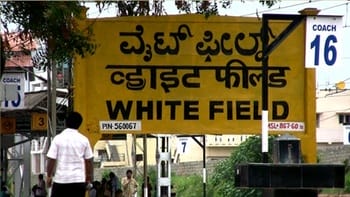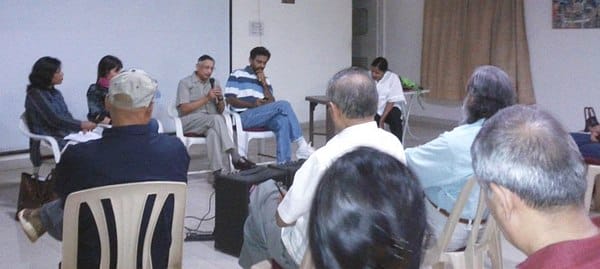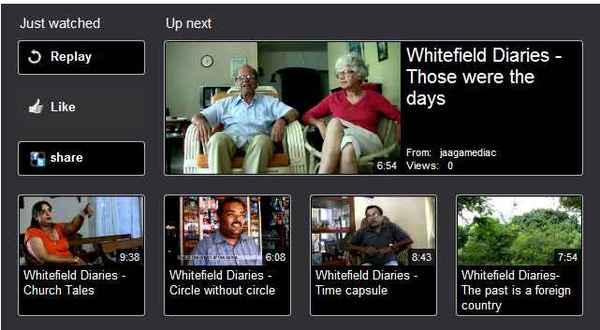In 1892, Whitefield was the only settlement in India that European and Eurasians could call their own. Old chronicles narrate that David Emmanuel Starkenburgh White decided to set up setttlement on a donation of land from the Maharajah of Mysore as a ‘self sufficient Anglo-Indian village’, where everyone worked for ‘the common good’. More than a century later, across a landscape where flashy malls and exclusive gated communities abound, Whitefield is home to the offices of multinational corporations like IBM, Hewlett Packard, SAP Labs, Dell, Cap Gemini, Oracle, GE Medical Systems, ABB and Unilever.

Whitefield Diaries is screening again on September 24th at Jaaga Media Centre, off KH Road. The films are also available on Youtube.com.
The changing face of Whitefield reflects the transformation, and even disintegration, of greater Bangalore.
Whitefield’s disappearing history and evolving multiple futures find expression in Whitefield Diaries, a series of six short films, documenting the community’s personal histories, tangible heritage and intangible socio-cultural legacy. Whitefield Diaries falls under the larger vision of Neighbourhood Diaries, a project conceived by Krupa Rajangam of Saythu and Archana Prasad of Jaaga, which sets out to document neighbourhood histories and heritage, using the short film format.
The idea took root when Krupa and Archana worked on Max Mueller Bhavan’s Bangalore City Project. But even before this, Krupa, a Conservation Architect had always been troubled by the “monument centric” approach to development. She believed that heritage conservation had to be directed at the memories of people, and Neighbourhood Diaries does just that.
Archana and Krupa chose Whitefield for this pilot episode as they were intrigued by the circular planning of the settlement. They also believed that there possible linkages with the European movement towards “green cities”. However, in the latter instance, they found that connections (if any) were slim.
As a project conceived as the documental of personal memories and histories, an important initial hurdle to this project was winning the trust of local residents. But once they had their collaboration, Krupa discovered that the community was proud of their heritage, and desired to protect it.
In collaboration with French filmmaker Clemence Barret, Krupa and Archana worked with the Whitefield community to piece together a compelling narrative that combines gentle humour with nostalgia, pathos and poetry. They finally challenge the Whitefield community to put forward their own solution to preserve their heritage in a changing world.
In the introductory film Circle Without Circle, the ‘man on the street’ in ‘modern Whitefield’ debates the meaning and reasons behind the original name. Whitefield clearly means many things to different people, and much of it builds on speculation. There are passing connections made with the Eurasian community of colonial times, but little else.
The panel discussion after the screening of Whitefield Diaries on September 10thm at the Whitefield Club. Pic courtesy: Krupa Rajangam.
Yet collective memory does run strongly through older residents. In later episodes, long term Whitefield residents Maggi and Vivian D’souza take us back in time to the original meaning, later symbolism and eternal romance of institutions like Memorial Church and Waverly Inn.
If J E Giddens is the pragmatic voice of the real estate developer who thrives in the growth of modern day Whitefield, Christa Moss is the lyrical poet who mourns the loss of her paradise. Finally, in The Whitefield Tea Party, descendants of the original settlers of Whitefield come together to discuss the future of their neighbourhood.
In the panel discussion and audience interaction that followed the first screening of these films at Whitefield Club on September 10th, long-time residents of Whitefield looked back nostalgically at a lost way of life and a fading old-world grace.

The panel discussion after the screening of Whitefield Diaries on September 10thm at the Whitefield Club. Pic courtesy: Krupa Rajangam.
Initiating the panel discussion, Asvathnarayan, Convener of the Karnataka Chapter of Indian National Trust For Art and Cultural Heritage (INTACH), spoke of the absence of legislation in Karnataka that protected the state’s architectural heritage. While cities like Mumbai and Delhi already had legislation that protected heritage sites, Karnataka had lagged behind.
Yet there were reason why Whitefield had to become a suburb in the dimming light of its twilight years. Subramaniam Vincent, co-founder of Citizen Matters and one of the newer residents of Whitefield, gave momentum to the discussion, pointing out that there were two facets to the current debate. The first one dealt with the intangible loss of a way of life, and this was not specific to Whitefield. Cities and communities across the country were dealing with the same problem as part of larger discussions on urban development. The second issue before the neighbourhood was the physical destruction of existing heritage sites.
While Karnataka still did not have the necessary legislation to protect heritage sites, Subramaniam believed that there were still avenues open under the existing framework. He cited a recent instance where R K Narayanan’s house was notified as a heritage building under the Karnataka Town and Country Planning Act. Were similar measures not open to Whitefield and greater Bangalore?
In this spirit, there were also important forward looking statements of action. Sean Lawrence announced Whitefield Day, tentatively scheduled for July next year, where residents would pay tribute to Whitefield’s rich heritage with events such as heritage walks through the area.
Deepa Peck, married into one of the original families that settled in Whitefield and Treasurer of the Whitefield Settlers’ & Residents’ Association, spoke of a future vision for a modern Whitefield, still rooted in the heritage of its past. While the Settlers’ Association was founded in 1905, Deepa hoped to see all new residents and communities joining the association to work towards developing Whitefield into a model neighbourhood.
Filmmaker Clemence Barret, also on the panel, noticed that while during the making of the film most residents had seemed pessimistic, the tone had now changed to optimism.
Ending the evening on a lighter note, Deepa recollected that at the end of the filming of The Whitefield Tea Party, Lionel and Christa Moss had left in a hurry to ‘bed their sheep’. Deepa observed, “There is probably no other place in Bangalore where you would hear people talking like that.” Lionel and Christa Moss actually had sheep!
(In case you missed the first screening, the next screening of Whitefield Diaries will be at Jaaga on September 24, 2011. Jaaga is located on KH Road. Moving on from Whitefield, Neighbourhood Diaries will be turning its lens on Malleshwaram next. They welcome any volunteers or funding support.) ⊕
